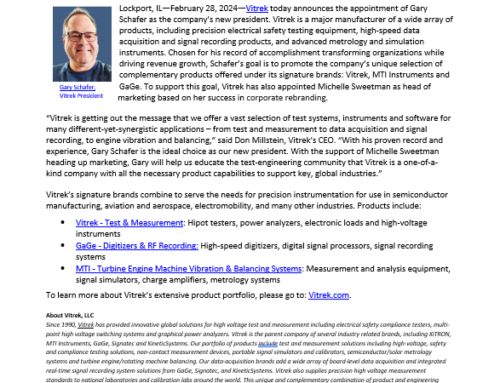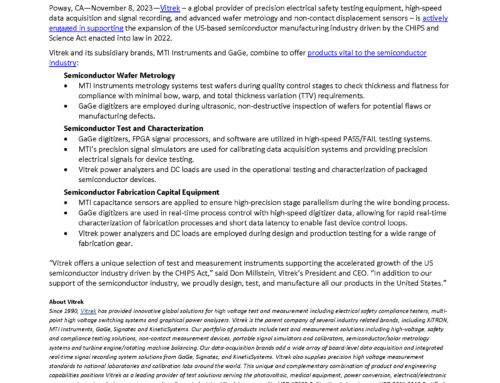Solving the Shortage of Aviation Technicians Through Product Design – Published by Aviation Maintenance Magazine
New, innovative aviation technology is a force multiplier when it comes to reducing job complexity to attract a greater pool of talent.
By Ken Ameika, MTI Instruments by Vitrek

The MRO industry is seeing an exodus of retiring mechanics — even as fewer young mechanics sign up to enter the trade. Exacerbating the situation is the extensive training and dated equipment aspiring technicians must contend with before they can join the workforce.
To find solutions, we can look at the adoption of advanced technologies by other industries over the last three decades. New technologies have enabled tasks to be performed by technicians that only a short time ago could only be done by highly trained professionals. For example, in the automotive industry conducting diagnostics over WIFI networks, applying advanced filtering on images, and analyzing millions of records with the touch of a button are now easy to do.
The Problem: Decreasing Workforce During Industry Growth
The aviation maintenance, repair and overhaul (MRO) sector is facing a growing personnel shortage. A top cause is that mechanics are retiring at an increasing rate. Before the pandemic, reports say the average age of an aircraft technician was 57. With airlines offering early retirement packages, the industry is facing an irreplaceable loss of knowledge.
At the same time, not enough young mechanics are joining the trade. According to the 2022 Aviation Technician Education Council (ATEC) Pipeline Report published in late November 2022, the pandemic is estimated to have cost the industry at least 5,000 new mechanics, creating an even bigger challenge in the talent pipeline shortage. ATEC president and dean of WSU (Wichita State University) Tech Aviation Program James Hall has been quoted as saying that, “The number of prospects in the mechanic pipeline needs to grow by at least 20% to meet industry’s needs; national enrollment at A&P schools is only growing at about 2% per year.”
Longer-term resource modeling is even more concerning. Oliver Wyman, a global leader in management consulting with deep industry knowledge and specialized expertise in strategy, operations and risk management, poses a stark assessment on its website. 2027, according to Oliver Wyman, is “projected to be the worst year for the shortage — the bleakest scenario has the supply deficit at more than 48,000 aircraft maintenance workers, a shortfall of about 27%.” (Figure 1)
Meanwhile, after two years of turmoil due to the pandemic, the aviation industry appears to be poised for a decade of growth. Oliver Wyman’s report entitled: “Global Fleet & MRO Market Forecast 2022–2032,” says there is optimism that the industry has turned the corner and is now on an upward trajectory. The report says: “At the beginning of 2022, the global fleet was the same size as it was in 2017, and it is not expected to top its January 2020 apex of almost 28,000 until sometime in the first half of 2023. By 2032, the fleet is expected to eclipse 38,100 aircraft, a compound annual growth rate (CAGR) of 4.1% between January 2022 and the beginning of 2032.” (Figure 2)
Although projected growth in the MRO industry is encouraging news, it adds to the hiring shortage problem. The following are several solutions the industry is trying, to solve the demand for new aviation technicians:
- Increased wages: According to industry resources, the median annual salary for aviation technicians has increased by approximately 23% from 2019 to 2023: Average 2019 salary according to Epic Flight Academy: $73,050. Average 2023 salary according to Salary.com: $89,822
- Better training: Local vocational schools and community colleges are offering A&P (Airframe and Powerplant) training programs and are collaborating with nearby MROs to attract, train and place young aviation technicians.
- Federal legislative efforts: Expanding access to A&P test prep courses and training not only provides relief to the civilian talent shortage but also eases military-to-civilian aviation career transitions for veterans entering the commercial workforce. This includes protecting or expanding the applicable uses for the GI Bill.
- Accelerated accreditation: Instead of taking the traditional career path of progressing from training to an MRO (or contract job or regional airline) and then to an airline, major carriers are hiring some A&P college students before they have even graduated.

Figure 1, Projection of N. American mechanic demand vs. supply in aviation personnel. (Source: Oliver Wyman.)
The Solution: Using Technology Innovations to Attract Technicians
Advancements in computing, the miniaturization of sensors and electronics, and better battery technology — combined with flat screens and touch enabled displays — create opportunities to re-imagine existing equipment by making it significantly easier and more cost-effective to operate and repair. Simplifying these tools also helps attract job seekers who might not consider themselves capable of working in industries with such high technical requirements as the aviation industry. Therefore, reducing equipment complexity means significantly expanding the addressable pool of talent.
The good news is that we are already seeing new diagnostic products and innovative approaches entering the aviation industry. To keep up with the growing demand and the widening resource shortfall, however, we need to speed up this effort and rethink how to simplify the work and further reduce operational complexity by applying the latest technology. This requires us to truly challenge the accepted norms for the minimum skill sets required to perform the job — and to put a heavier burden on technology rather than the technician.
The following section shows how three new diagnostic products developed by three different MRO equipment manufacturers demonstrate this concept in action. This equipment is presented to exemplify the new thinking the industry needs to embrace when defining the skill set of an aviation technician. These technologies place a heavy emphasis on reducing complexity and focus on ease of use and speeding up diagnostics.

Figure 2. The aviation industry is projected to grow over the next 10 years.
Example 1: Electrical Wiring Troubleshooting
The wiring diagnostic company, WiN MS, offers aviation technology for monitoring the state of health of onboard electrical networks and complete infrastructures. It promotes its Aero Smart-R Kit as “the easiest tool to perform fast and accurate troubleshooting on electrical wiring systems.”
The all-in-one kit utilizes reflectometry, a radar principle in which a sensor sends an electromagnetic wave over the cable. This wave is partially or totally reflected when it encounters defects or anomalies. The resulting tool ensures essential time savings for operators by reducing downtime and improving productivity. Coupled with powerful analysis algorithms, the data from WiN MS tools bring new benefits for technicians including state-of-health knowledge at regular intervals of a fleet or installations and the ability to identify anomalies upstream and anticipate failures.
Aero Smart R-Kit – key benefits for technicians include faster wire inspection than the traditional method, one box for any cable and any aircraft, only one parameter to setup and wireless connection for high mobility.
Example 2: Aircraft Dent Measurement and Detection
The Iris dentCHECK drone combines innovations from two companies: Donecle’s drone technology and 8tree’s dentCHECK 3D sensor technology. The Iris dentCHECK is designed to fly around an aircraft checking flaps, slats, radome, doors and fuselage. During the drone’s pilot-free, fully autonomous flight, its 3D sensor finds and measures dents on aircraft down to 0.1mm-depth accuracy.
The dentCHECK drone is positioned by the company as being able to “detect and measure dents and buckles on the surface of the aircraft 50 times faster than manual methods.” This digitized method, it says, “slashes dent-mapping/reporting times by 90 percent,” compared with traditional methods.
Iris dentCHECK – key benefits for technicians include 50 times faster detection than manual methods and claims that it can help cut dent-mapping reporting by 90 percent.
Example 3: Turbofan Vibration Analysis and Balancing
The PBS eXpress, an aircraft engine vibration analysis and balancing system from MTI Instruments runs advanced algorithms to record vibration and speed, and generates a one-shot balancing solution for small-frame turbofan and turboprop engines, commonly used in regional business jets and general aviation.
The portable, handheld PBS eXpress (Figure 7) is based on the same technology as the company’s well-known PBS-4100+ products and adds a modernized touchscreen and other advanced functionality. This includes Balance Wizard technology that significantly streamlines the diagnostic and balancing process. According to the company, the system’s “intuitive user interface enables first-time users to perform vibration analysis and engine rotor balancing, with minimal training.”
PBS eXpress – key benefits for technicians include:
- Easy to set up: preconfigured engine parameters. Just connect cables and begin testing.
- Intuitive touch-based user interface.
- Guides even first-time users to success in as little as two engine runs
- Works with existing cable sets for enhanced migration capabilities.

Figure 3. The handheld PBS eXpress system uses advanced, modern functionality for extremely simplified turbofan vibration analysis and balancing.
Conclusion
When one looks at today’s aviation MRO industry, the misconception of the younger generation’s expectations of the skill set needed to join the workforce is significant. Much of the industry’s electronic equipment was developed at least 20 years ago and is unintuitive, difficult to use and cumbersome. As a consequence, the operation of such tools is reserved for older, experienced staff, who are increasingly scarce. In contrast, the advanced technologies shown in the examples above — 3D sensors, drones, WiFi networking and touchscreens — are being utilized to make emerging MRO equipment dramatically easier to operate by the next generation of more technology-savvy technicians.
New, innovative aviation technology is a force multiplier when it comes to reducing job complexity and attracting a greater pool of talent to this exciting industry —
an industry in desperate need of workers on the cusp of a decade of growth.



